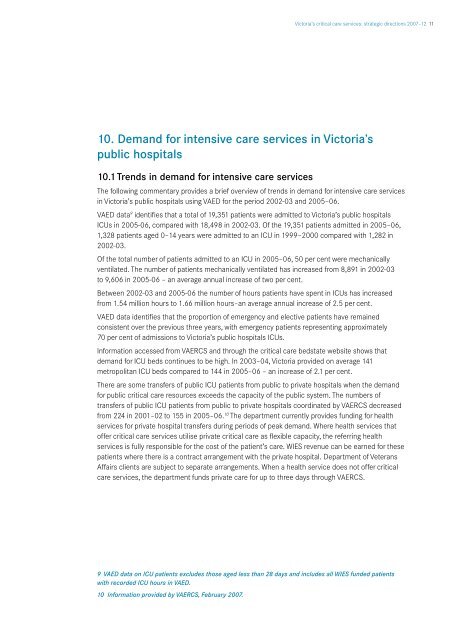Victoria's critical care services Strategic directions 2007–12
Victoria's critical care services Strategic directions 2007–12
Victoria's critical care services Strategic directions 2007–12
Create successful ePaper yourself
Turn your PDF publications into a flip-book with our unique Google optimized e-Paper software.
Victoria’s <strong>critical</strong> <strong>care</strong> <strong>services</strong>: strategic <strong>directions</strong> <strong>2007–12</strong> 11<br />
10. Demand for intensive <strong>care</strong> <strong>services</strong> in Victoria’s<br />
public hospitals<br />
10.1 Trends in demand for intensive <strong>care</strong> <strong>services</strong><br />
The following commentary provides a brief overview of trends in demand for intensive <strong>care</strong> <strong>services</strong><br />
in Victoria’s public hospitals using VAED for the period 2002-03 and 2005–06.<br />
VAED data 9 identifies that a total of 19,351 patients were admitted to Victoria’s public hospitals<br />
ICUs in 2005-06, compared with 18,498 in 2002-03. Of the 19,351 patients admitted in 2005–06,<br />
1,328 patients aged 0–14 years were admitted to an ICU in 1999–2000 compared with 1,282 in<br />
2002-03.<br />
Of the total number of patients admitted to an ICU in 2005–06, 50 per cent were mechanically<br />
ventilated. The number of patients mechanically ventilated has increased from 8,891 in 2002-03<br />
to 9,606 in 2005-06 – an average annual increase of two per cent.<br />
Between 2002-03 and 2005-06 the number of hours patients have spent in ICUs has increased<br />
from 1.54 million hours to 1.66 million hours–an average annual increase of 2.5 per cent.<br />
VAED data identifies that the proportion of emergency and elective patients have remained<br />
consistent over the previous three years, with emergency patients representing approximately<br />
70 per cent of admissions to Victoria’s public hospitals ICUs.<br />
Information accessed from VAERCS and through the <strong>critical</strong> <strong>care</strong> bedstate website shows that<br />
demand for ICU beds continues to be high. In 2003–04, Victoria provided on average 141<br />
metropolitan ICU beds compared to 144 in 2005–06 – an increase of 2.1 per cent.<br />
There are some transfers of public ICU patients from public to private hospitals when the demand<br />
for public <strong>critical</strong> <strong>care</strong> resources exceeds the capacity of the public system. The numbers of<br />
transfers of public ICU patients from public to private hospitals coordinated by VAERCS decreased<br />
from 224 in 2001–02 to 155 in 2005–06. 10 The department currently provides funding for health<br />
<strong>services</strong> for private hospital transfers during periods of peak demand. Where health <strong>services</strong> that<br />
offer <strong>critical</strong> <strong>care</strong> <strong>services</strong> utilise private <strong>critical</strong> <strong>care</strong> as flexible capacity, the referring health<br />
<strong>services</strong> is fully responsible for the cost of the patient’s <strong>care</strong>. WIES revenue can be earned for these<br />
patients where there is a contract arrangement with the private hospital. Department of Veterans<br />
Affairs clients are subject to separate arrangements. When a health service does not offer <strong>critical</strong><br />
<strong>care</strong> <strong>services</strong>, the department funds private <strong>care</strong> for up to three days through VAERCS.<br />
9 VAED data on ICU patients excludes those aged less than 28 days and includes all WIES funded patients<br />
with recorded ICU hours in VAED.<br />
10 Information provided by VAERCS, February 2007.

















